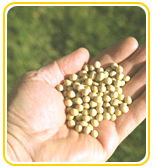| |
| |
 |
What is biodiesel?
Biodiesel is a naturally oxygenated fuel produced from organic feed sources such as soybeans, cooking oil, and animal fats. Biodiesel can be used in its pure form (B100 or "neat") or blended at a 20% ratio with petroleum diesel (B20) to achieve cost efficiency and improve cold weather performance. |
|
| |
 |
| |
What types of vehicles can use biodiesel?
Biodiesel can be used in any diesel vehicle without modification. It is used extensively in parts of Europe and is gaining support in the United States. Applications include buses, delivery trucks, waste disposal and recycling trucks, construction and farm equipment, heavy-duty freight hauling, and boats. |
|
| |
 |
| |
How does biodiesel perform?
 Biodiesel performs just like traditional diesel, though B100 may result in a minimal power loss at the high end and a slight reduction in fuel economy. B20 users generally experience no marked difference in fuel economy from petroleum diesel. ASTM International has reviewed biodiesel performance and issued a final specification (users should be sure that any fuel they purchase meets ASTM D6751). Biodiesel performs just like traditional diesel, though B100 may result in a minimal power loss at the high end and a slight reduction in fuel economy. B20 users generally experience no marked difference in fuel economy from petroleum diesel. ASTM International has reviewed biodiesel performance and issued a final specification (users should be sure that any fuel they purchase meets ASTM D6751).
Because biodiesel acts as a lubricant, it reduces wear and tear on the engine, reducing maintenance costs and extending engine life. Biodiesel remains blended with petroleum diesel so it can be easily stored and dispensed in existing facilities. Biodiesel thickens more than diesel fuel in cold weather and special systems or minor modifications are required for use of B100. Vehicles produced prior to 1993 should have rubber seals in fuel pumps and fuel systems replaced with non-rubber (Viton) seals. |
|
| |
 |
| |
 |
What are the benefits of using biodiesel?
Biodiesel results in significantly lower emissions of particulate matter, carbon monoxide, toxic contaminants, sulfur dioxide, hydrocarbons, visible smoke and noxious odors than petroleum diesel. Depending on the feed source, biodiesel can result in lower life-cycle carbon dioxide emissions.
|
|
| |
Emissions reductions achieved by biodiesel as compared to petroleum diesel. |
|
| |
Source: http://www.afdc.doe.gov/pdfs/5450.pdf |
|
| |
| Emission |
B100 |
B20 |
| Carbon Monoxide |
43.2% |
12.6% |
| Hydrocarbons |
56.3% |
11.0% |
| Particulates |
55.4% |
18% |
| Sulfates |
100% |
20% |
| Nitrogen Oxide |
+5.8% |
+1.2% |
| Air Toxics |
60-90% |
20% |
|
|
|
| |
Biodiesel is non-toxic and biodegradable and therefore does not pose a threat to water and soil resources if B100 is spilled. Producing biodiesel from restaurant oil or animal processing wastes reduces the amount of materials overcrowding landfills. Additionally, biodiesel is one of the safest fuels to use, handle, and store because it does not produce combustible vapors and has a higher flash point (300° F) than petroleum diesel. Significant benefits of biodiesel include reducing our dependence on foreign oil and providing alternative markets for farmers. |
|
| |
|
|
| |
|
|
|


